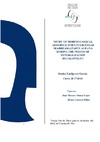Identificador persistente para citar o vincular este elemento:
https://accedacris.ulpgc.es/jspui/handle/10553/75037
| Título: | Study of morphological abnormalities in gilthead seabream (Sparus aurata) during the period of mineralization development | Autores/as: | Lindgreen García, Jessica | Director/a : | Afonso López, Juan Manuel Lorenzo Felipe, Alvaro |
Clasificación UNESCO: | 251092 Acuicultura marina | Palabras clave: | Seabream Deformity Osteology Larvae Mineralization |
Fecha de publicación: | 2018 | Proyectos: | Consumer driven Production: Integrating Innovative Approaches for Competitive and Sustainable Performance across the Mediterranean Aquaculture Value Chain | Resumen: | The Gilthead seabream (Sparus aurata) is one of the most important marine species of Mediterranean aquaculture, which is commercialized as whole fish. This is the reason why skeletal deformities cause economic losses to the companies, so it is desired to decrease the prevalence and severe deformities from early stages of development to avoid the high maintenance costs of the fish. This work studies, during the mineralization larvae phase, the relationship of larvae morphotypes according its sampling days and larvae size classes, and its connection with the degree of mineralization during the first stages of larval development. Breeders selected (3 females and 3 males) for high growth from the second generation of PROGENSA®, were used to obtain larvae batches. Initially, an exhaustive description of morphotypes or types of deformities was realized, involving samples collected from day 26 to day 75, locating the exact window of development, in term of space-time dimension, where deformities appeared. A log-lineal mathematical model was applied on data base, in order to study the interaction between different approaches to group morphotypes (deformed & normal, severity, simple & complex, location on body area) against sampling days and larvae size classes. Thirty morphotypes were described, including the normal morphotype, distributed between simples (five) or complexes (twenty-four), according the number of deformities presented, one or more respectively. All deformities of column (Lordosis, Scoliosis, kyphosis, fusion) were correlated significantly in a positive sense. Only scoliosis and kyphosis were negatively correlated with jaw deformity. Glossohyal was a deformity highly frequent but linked significantly with jaw deformity, and no with column deformities. No interaction between sampling Days and morphotypes (Deformed & Normal) was detected. Significant interactions between larvae size class and groups of morphotype were detected (deformed & normal, severity, simple & complex, location on body area). Thus, were detected associations between low prevalence of deformed larvae, complex and severe and nonsevere morphotypes with the highest size class (2.5-3mm). An association between high prevalence of complex, severe and non-severe and head-column-caudal morphotypes with 1-1.5 mm size class. Considering the head deformities, they reported a significant defect at the lowest size class (0.5-1 mm), as simple morphotype and combined with column and caudal deformities, while it reports a significant excess of normal larvae. Thus, the appearance of different morphotypes is explained by size class effect more than days of age. According the body area, the appearance of morphotypes was in concordance with the natural mineralization process, which begins at the head, continues through the column, and achieves the caudal area at the end of ossification process. | Departamento: | Departamento de Patología Animal, Producción Animal, Bromatología Y Tecnología De Los Alimentos | Facultad: | Facultad de Ciencias del Mar | Titulación: | Grado en Ciencias del Mar | URI: | https://accedacris.ulpgc.es/handle/10553/75037 |
| Colección: | Trabajo final de grado Restringido ULPGC |
En el caso de que no encuentre el documento puede ser debido a que el centro o las/os autoras/es no autorizan su publicación. Si tiene verdadero interés en el contenido del mismo, puede dirigirse al director/a o directores/as del trabajo cuyos datos encontrará más arriba.
Vista completaVisitas
52
actualizado el 10-ene-2026
Descargas
16
actualizado el 10-ene-2026
Google ScholarTM
Verifica
Comparte
Exporta metadatos
Los elementos en ULPGC accedaCRIS están protegidos por derechos de autor con todos los derechos reservados, a menos que se indique lo contrario.
